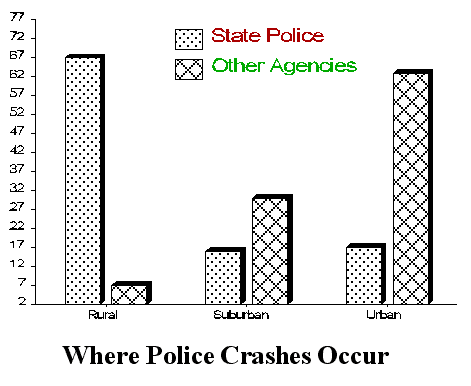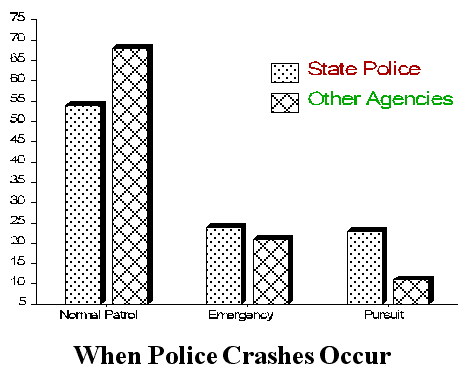















Traffic Tech #104: IACP Law Enforcement Fleet Crash Study |
|---|
|

Number 104 September 1995
IACP LAW ENFORCEMENT FLEET CRASH STUDY
In 1986, the International Association of Chiefs of Police (IACP) conducted a crash study to learn where and how often law enforcement officers were crashing. Recently, the IACP sent a followup survey to all IACP member agencies to update information about incidents of injury from police crashes. Six hundred and twenty-six agencies responded. Several of the larger municipal law enforcement agencies and state police and highway patrol agencies provided indepth information about their fleet crashes. An 18 page report summarizes the findings of this new survey, based on crash data from 1988 through 1994.
Law Enforcement Officers at Risk in Motor Vehicles Crashes
Law enforcement officers are more likely to be involved in a crash than the average driver because of the nature of their work. They drive in all kinds of weather, patrol for long periods, drive many miles in complex traffic and often at night, and must focus their attention on their surroundings while driving. Plus police vehicles have additional special equipment that may increase risks of injury.

State law enforcement agencies reported 13.12 crashes per million miles traveled, while other law enforcement agencies (city, township, county police and sheriff's offices) reported 25.3 crashes per million miles traveled. As the figures show, about two thirds of these crashes happen in rural areas for state police, and in urban areas for other police agencies. Police officers crash where they work and more than half of the crashes occur during normal patrols.

State law enforcement agencies reported that 11 percent of their crashes resulted in an injury to an officer. Other law enforcement agencies report that their injuries have declined to about 15 percent, down from 24 percent in the earlier study. Today, 100 percent of state law enforcement agencies, and 95 percent of other law enforcement agencies, have a safety belt use policy in effect for their officers.
What Do Fleet Crashes Cost a Law Enforcement Agency?
Law enforcement agencies face three major cost items as a result of fleet motor vehicle crashes -- worker's compensations benefits, civil law suits, and vehicle repair and replacement expenses.
The average worker's compensation benefit paid each year per state law enforcement agency is $161,003, and for other law enforcement agencies, the average is $117,190.
In this study, 93 percent of the state law enforcement agencies and 51 percent of the other law enforcement agencies reported they have had civil suits filed against them as a result of a motor vehicle crash. These percentages are representative only of the agencies who responded to the survey and may not reflect all of the police agencies in the IACP membership.
State agencies spent an average of $214,000 per year per agency on repairs or replacements to department vehicles because of vehicle crashes, and other law enforcement agencies spent an average of $125,400.
Copies of the IACP Law Enforcement Fleet Crash Study are available from the International Association of Chiefs of Police, NHTSA Regional Offices, State Highway Safety Offices, or by writing to the Office of Enforcement and Emergency Services, NHTSA, NTS-41, 400 Seventh Street S.W., Washington, DC 20590, or by sending a fax to (202) 366-7721.
U.S. Department of Transportation
National Highway
Traffic Safety
Administration
400 Seventh Street, S.W. NTS-33
Washington, DC 20590
Traffic Tech is a publication to disseminate information about traffic safety programs, including evaluations, innovative programs, and new publications. Feel free to copy it as you wish.
If you would like to receive a copy contact:
Linda Cosgrove, Ph.D., Editor,
Evaluation Staff Traffic Safety Programs
(202) 366-2759
